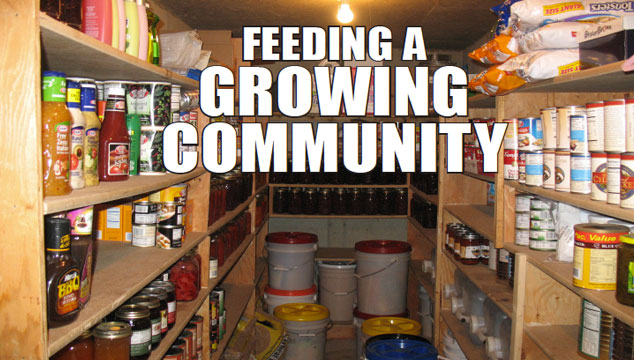
The USA is in a particularly precarious position when it comes to food production. Back in the Great Depression, Americans were able to put hoe to soil and garden their way out of famine. At the time 25% of Americans were producing food already and another 25% had parents who did so were able to get viable gardens going. They saved the nation.
It appears that we didn’t learn our lesson because fewer than 2% of Americans engage in any type of food production today. Much of our food is shipped in from other continents. How’s that going to work if the grid, banking, transportation, fossil fuels, the workforce, or the internet breaks down? Quite simply, it won’t work.
Sustainably Feeding a Large Group Doesn’t Happen Overnight
I hear it all the time. A neophyte prepper proudly explains how they have a seed bank that was purchased online and have the tools to till under their lawn. They claim this will turn into a productive garden.
“Have you gardened before?”
“No, but I have books. How hard could it be? We’ll figure it out.”
A Seasonal Prospect
Outdoor gardening happens by growing season. We can grow amazing fruit all year round in Brazil with precious little effort once the trees are established. We’re closer to the equator and there is abundant rain along the coast. Labor is cheap, too. Here in the US we’re farther from the equator so the growing season is much shorter. Many crops are planted in the spring and grow through the summer. Then they’re harvested and preserved in the fall. This harvest is stored for the rest of the year, to get us through tough times, and any disastrous growing seasons in years to come.
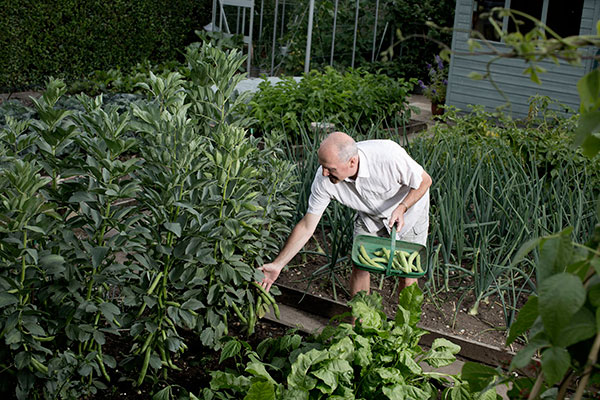
Thus the learning curve of the gardener or farmer also happens largely by growing season or year. Experience builds slowly. Changes also take about a year or so to implement. Becoming a productive gardener takes years. If you haven’t started yet, now is the time!
When an emergency happens, you want to be continuing and expanding existing efforts. You’ll be in trouble if just starting from scratch. From the food production perspective, the worst time for an EMP would be late summer or early fall. It would be 9 months or more before a scrap of food could be grown in the northern states.
The Law of the Harvest
You reap what you sow is a nugget of wisdom understood by anyone who has toiled in the earth. The amount of food produced is directly correlated to the sweat and toil put into it. In this case it’s literal.
Soil Analysis and Seed Choice
Soil should be analyzed and prepared as needed. Local universities typically have good prices, accurate analysis, and follow proper procedure. Don’t count on being able to till your lawn under and find a thick layer of rich, loamy topsoil free of rocks.
Simply purchasing a vault of heirloom seeds isn’t enough. Procuring heirloom seeds locally will help make sure they’re varieties already acclimated to the local climate and soil composition. This will make them a lot more effective.
Food Storage
Why not go right into gardening and livestock? Because producing food takes time. Plus you must live long enough and have energy to make it happen.
How Much is Enough?
Absolute minimum food storage for long-term survival is a year. I plan on more than two and know it’s still not enough. Why so much? Because it will be a year before we can grow food. I know that the first year’s harvest won’t be sufficient. I also know that there will be starving family and neighbors. Is the over two years of food I have stored enough? Absolutely not. It’s going to take a lot of hard work and even harder decisions to survive even with over two years of food storage. What it does do is give me some time to think and act.
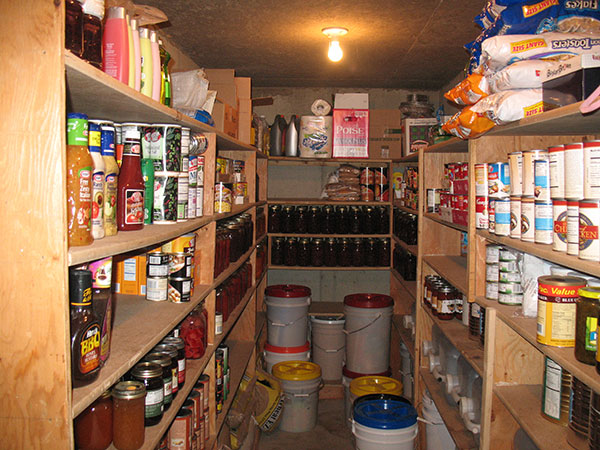
What to Store – Diversified Food Storage
Which food is best? Do I buy dry pack, freeze dried, MREs, or what?
My family has been storing food for over 100 years, so we have learned a thing or two along the journey. The answer depends somewhat on your group makeup, medical conditions, climate, plans, and other factors. For most groups who do regularly eat and rotate their long-term food storage, a diversified model makes the most sense.
Diversified Food Storage Model
- 90 Days of Shelf Stable Foods That You Normally Eat for Short-Term Storage – These should be rotated through.
- Dry Pack Long-Term Food Storage – I prefer to pack dry goods in #10 cans with oxygen absorbers. They’re labeled, dated, then packed six to a cardboard box with two plastic lids per box to preserve and keep bugs out of food. I recommend #10 cans as they’re both pest and rodent proof. Plastic buckets aren’t! Shelf life for most dry raw foods packed in this manner is 30 years. This rivals freeze drying for storage life. Food storage should be kept in a cool, dark place and preferably at a constant temperature.
- Wet Packed Long-Term Food Storage – Wet packed foods should be pressure canned. One of my grandfathers was a military surgeon and public health official. He used essentially the same technique to sterilize medical instruments when an autoclave wasn’t available. Food stored in this manner is be microbiologically safe for an indefinite period of time. Safe as long as the container integrity is preserved and proper technique is observed in the canning process. The food may lose some color, taste, and texture. Plus it will lose some vitamins and nutritional value after 20-30 years. But the food is typically still safe to eat. I rotate all food after 30 years to preserve nutrition, taste, and texture.
- Freeze Dried Food Storage– Freeze dried food storage is nice to have on hand. You don’t have to use hot water to reconstitute it. However, it will taste better with hot water. Freeze dried food uses less fuel, time, and spices to prepare when compared to dry packed. Also because it’s so lightweight, it’s more desirable for travel. It’s especially preferable if you’re traveling on foot and in cold weather. My favorite freeze dried food for long range foot travel is the Long Range Patrol/Cold Weather Ration. I typically choose Mountain House freeze dried meals that are vacuum packed in cuboid shapes. These pack more densely than the ovoid shaped Mountain House Pro Packs and other freeze dried meals. They’re high in calories with plenty of protein, fat, and carbs.
- MRE’s – Don’t believe everything you hear about MREs stopping you up, giving you the squirts, and tasting terrible. I ate only MRE’s and other US rations for over six months straight with absolutely no ill effects. MREs are nice to have when you don’t have time to cook, when tactical considerations dictate a cold camp, and short-term travel by vehicle. Storage life is highly temperature dependent. Every 10 degrees above 70 degrees Fahrenheit cuts shelf life in half. MREs use little water to prepare, and history shows that people will kill for them when they’re hungry.
- Low Moisture Survival Rations – Low moisture foods are important for storing in vehicles. In southern states, a wet MRE entrée won’t last a summer in the cab of a truck. Low moisture rations like survival bars used in lifeboats, millennium bars, or US Military GP Survival Rations last far longer. I have eaten them after 11 years knocking around in my truck in Arizona!
Caches
Don’t put all your eggs in one basket. Cache some of your food storage. Put two #10 cans of beans, a can of rice, a can with bullion/soup/gravy base, salt, sugar, spices, a little hanger wire, and a ferro rod stuffed in a PVC pipe in some cache spots. This will provide filler for a lot of meals. Use #10 cans of Mountain House if you have the money.
Home Food Production
To achieve a degree of self-reliance, food must be produced and preserved in a root cellar or using renewable energy. If you’re living in an apartment or a townhome start a vertical garden, window box, or container garden. Many communities and schools rent garden spots to members of the community. These programs provide a way to meet someone who can mentor you in gardening. It’s also a way to learn the skills you and your group needs.
Gardening & Orchards
Your group will need land, water, sun, topsoil, seed, soil amendment, fertilizer, tools, knowledge, experience, and specific supplies to grow food crops in a garden. No water is an absolute deal breaker where land for a retreat is concerned. Water is the first thing to check when looking for land and that goes triple out west. A tractor or rototiller will help a great deal if you’re in a large enough group with enough land. Human resources also factor heavily into success.
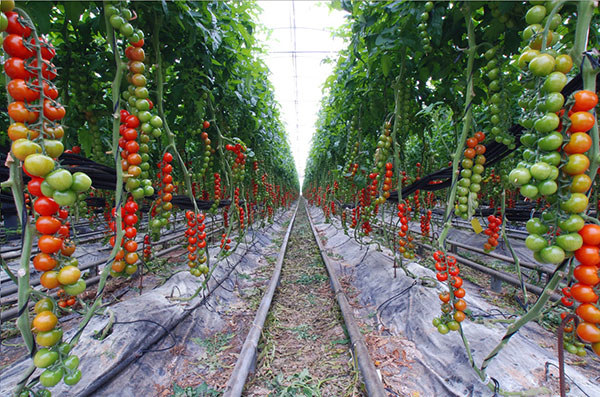
I have yet to hear of a homestead with perfect soil. Where I chose to live, we have abundant water which is hard to find in the West. However, we have alkaline soil that causes iron deficiency. No matter where your land is, there will be challenges to overcome. You’ll also have to keep out pests, birds, and varmints, including the human variety. I suggest reading Secret Garden of Survival by Rick Austin to learn how to grow gardens that don’t look like gardens. It contains advice on things like xeriscaping and plants that can be planted together to discourage both pests and prying eyes.
Fruit trees are wonderful but also take years to take root and mature. Plant them as soon as possible. They are worth the investment though. Fruit trees produce years of tasty fruit, jams, butters, juices, and nectar. They’ll often produce well with precious little care. I hiked into Arizona’s Superstition Mountains to visit Reavis Ranch. Over 120 apple trees still remain nearly a hundred years after Elisha Reavis died. Fruit trees can pay off for a long time.
Livestock
Most Americans are used to a diet that’s high in meat and protein. Unless you live on a ranch, this will have to change. Most survivalists will have to learn to eat to live instead of live to eat. Visions of an apocalypse filled with bacon and booze is fanciful for most. Survival conditions often require serious adaptation.
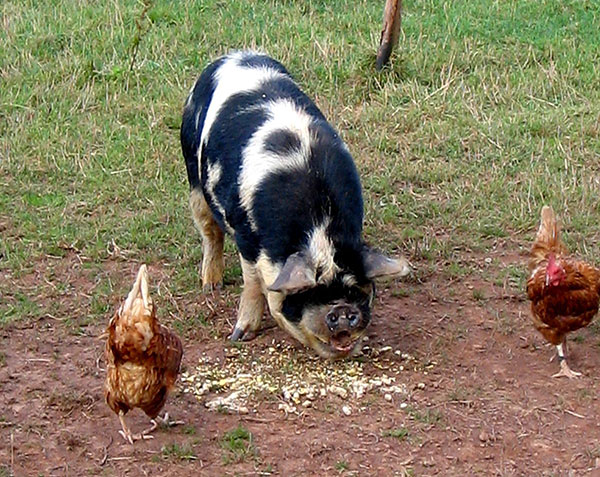
Many farms have a dairy cow or two and chickens. They’ll produce needed eggs and dairy products. Rabbits or pigeons can be kept even in more urban areas. Survivalists tend to want to think outside the box. Perhaps it’s in our nature, but I wouldn’t get too exotic with livestock. Stick with tried and true breeds that locals know and understand.
Lastly, livestock requires constant care. You’ll notice that farmers tended to have large families to provide the labor necessary to run a farm. Caring for livestock is more easily accomplished in a group, especially if you aren’t farming full-time.
Aquaponics
Aquaponics uses a combination of fish ponds and gardens to create a closed, self-sustaining ecosystem. This can produce vegetables, greens, and fish. It produces a great deal of food in a little space and has become popular in suburbs.
Scavenging, Gathering and Hunting
Many survivalists plan on heading for the mountains to live off the land. There are places where this is possible. However, if even a small percentage of the population has the same idea big game levels will quickly fall to near extinction.
What will persist in sparsely populated areas is edible plants. Edible forage and small game will feed most gatherer-hunter populations. I say gatherer-hunter to illustrate the point. You could easily survive off wild edibles even in densely populated areas at present. Keep in mind that human beings will quickly learn which plants are edible and scour the earth like a plague of locusts in these areas.
Do toss garden pests in the stew pot, fish, trap and hunt where it makes sense. However, remember that the agricultural revolution yielded a 50-fold increase in standard of living over the gatherer-hunter lifestyle.
Expert Takeaways
- Tilling your lawn under and planting seeds out of cans that came from 20 states away isn’t a viable food production strategy. You need to be gardening now.
- Diversified food storage is more effective than storing only one type.
- Low moisture foods like lifeboat and US Military GP Survival Rations fare better in the fluctuating temperatures encountered in vehicles than foods with higher moisture content.
- A combined strategy of both food storage and production is needed for a large group to survive long-term.
